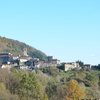San Romano in Garfagnana
The village of San Romano in Garfagnana was built around the homonymous church which was erected under the rule of the noble house of Gherardinga, a family which, throughout most of 1200s, boasted the rights to this settlement on the slopes of the hill on which stood the two fortresses of the "Verrucola Gherardenga".
The Romanesque Church of San Romano Martire was rebuilt in the eighteenth century. It houses a wooden statue of the saint dating from the seventeenth century and two painted wooden statues representing Santa Cristina and Santa Margherita.
Historical notes
At the end of the thirteenth century, the village passed to the city of Lucca. San Romano, in fact, was one of the villages that participated in the procession of the Holy Cross as an act of submission to the government of Lucca. Initially the centre was placed inside the Vicariate "a Perpore Supra", based in Castiglione Garfagnana, then, in 1272, it became part of the Vicariate of Camporgiano.
After the death of Castruccio Castracani (1328), San Romano was given in fief to Spinetta Malaspina who kept it in his full possession until 1369, the year in which Lucca, regaining freedom from the yoke of Pisa, came to assert its authority over most of the Garfagnana.
The period of peace that characterised the Guinigiano period was put to the test in 1430 when the Lord of Lucca fell out of favour; after a few years of submission to Florence, the villagers then entrusted themselves to the protection of Lionello d'Este, Marquis of Ferrara.










